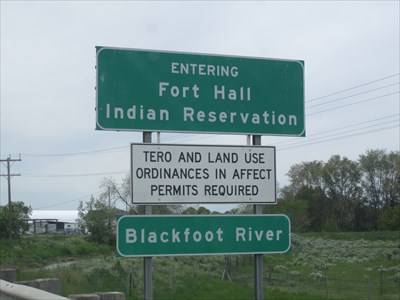
Following the American Civil War, the federal policy toward Indians was to confine them to reservations and to reduce the size of reservation to accommodate non-Indian agricultural, grazing, mining, and railroad interests. On the reservation, Indians were to become farmers, even if the reservation land was not suitable to farming; they were to become English-speaking and use of Native languages was often punished; and they were to become Christian and to accomplish this Native religious practices were suppressed, sometimes with force of arms.
From the viewpoint of many federal officials, Indians were Indians were Indians: in other words, they often failed to recognize that there were differences between tribes. In creating reservations, the United States often put tribes which had different cultures, languages, and religions on the same reservation assuming that all Indians were the same.
The Fort Hall Reservation
When the first non-Indians from the Mormon settlements in Utah began to discover what is now southern Idaho, they found that it was occupied by two somewhat related tribes: the Shoshone (also spelled Shoshoni) and the Bannock. Culturally, the two tribes shared a common heritage and a similar worldview. They spoke closely related languages. Historian John Heaton, in his book The Shoshone-Bannocks: Culture and Commerce at Fort Hall, 1870-1940 writes:
“Shoshones spoke Central Numic, whereas Bannocks, who began to intermarry with Shoshones in Idaho in the early eighteenth century, spoke Western Numic.”
The Shoshone tribes were found throughout the Great Basin area. Those who lived in southern Idaho are generally grouped together as Northern Shoshone and included the Fort Hall Shoshone, the Lemhi Shoshone, the Mountain Shoshone, the Bruneau Shoshone, and the Boise Shoshone.
The Bannock, who call themselves Bana’kwut (“Water People”), were called Buffalo Eaters and Honey Eaters by other tribes. The Bannock had migrated into the southern Idaho area from the desert areas of southeastern Oregon.
In 1867, President Andrew Johnson issued an executive order creating the Fort Hall Reservation in Idaho for the Boise-Bruneau Shoshone. The executive order also set aside 1.8 million acres as a separate reservation for the Bannock. Two years later, the Fort Hall Reservation was formally opened for the Shoshone and Bannock. In their book An Introduction to the Shoshoni Language: Dammen Daigwape, Drusilla Gould and Christopheer Loether report:
“The opening of the reservation began a period of ethnic cleansing and hardship for the Shoshone-Bannock unlike anything they had ever experienced before. They were forcibly removed from their homes and sent to the reservation. On the reservation they found little food, no opportunities, and very little hope for the future.”
The Government and Christian Missionaries
In 1869, the Board of Indian Commissioners recommended that, with regard to Indians, it was the duty of government to:
“protect them, to educate them in industry, the arts of civilization, and the principles of Christianity.”
The Board of Indian Commissioners also recommended that schools be established to introduce English to every tribe. According to the Board:
“The teachers employed should be nominated by some religious body having a mission nearest to the location of the school. The establishment of Christian missions should be encouraged, and their schools fostered.”
In 1870, President Ulysses Grant established his Peace Policy in which the administration of reservations was turned over to Christian missionary groups. According to James White in an article in Chronicles of Oklahoma:
“Under the terms of the Peace Policy, a single religious group had a franchise over the evangelizing efforts on each reservation.”
Under the Peace Policy, the Shoshone and Bannock of the Fort Hall Reservation were assigned to the Methodist Episcopal Church in 1871. The church, however, failed to send a missionary to the reservation. The Indian agent requested funds to build a mission and mission residence, but the federal government did not earmark any monies for this purpose. According to Brigham Madsen, in his book The Northern Shoshoni:
“When no funds were earmarked for these purposes, apparently the church again responded with dedicated apathy.”
In 1871, a Catholic priest visited the Shoshone and Bannock on the Fort Hall Reservation and requested that the reservation be re-assigned to the Catholic Church. The Department of the Interior responded by transferring it from the Methodists to the Catholics. The Catholic missionary, however, was on the reservation for only a few months and then left because there were no facilities for him.
In 1873, the Shoshone and Bannock of the Fort Hall Reservation were assigned to the Methodist Church. The new Indian agent preached sermons to the Indians, but one army officer charged that the agent was not promoting material progress on the reservation.
In 1875, an Indian teacher from the Methodist Episcopal Church was appointed to the Shoshone and Bannock of the Fort Hall Reservation. He organized a church society of six members, held church services every Sunday, and established a Sunday school.
In 1887, the Connecticut Indian Association, an auxiliary of the Women’s National Indian Association, contacted the Fort Hall Reservation. The Association was willing to send two missionaries to convert the Shoshone and Bannock if the government would build a cottage for them, provide them with 3-4 acres of land, and allow them to get supplies from the government store. As a result, two women missionaries arrived at the reservation.
Mormons
Like American Indian religions, the Church of Jesus Christ of Latter Day Saints, commonly called the Mormons, was discouraged by the American government and many reservations were closed to Mormon missionaries. The Mormon missionaries often worked among off-reservation Indians.
Mormon missionaries under the leadership of George Washington Hill traveled to southern Idaho in 1873 where they baptized about 100 Shoshone and Bannock. Lawrence Coates, in an article in Idaho Yesterdays, writes:
“Relying upon his previous experiences with the Shoshoni, Hill used his ability to speak their language to tell them of the Book of Mormon, depicting its story by placing pictures on a scroll.”
The Indians were then settled on farmland near Brigham City, Utah. The Indians named the community Washakie, after a Shoshone Chief.
In 1877, in response to the establishment of a Mormon farm for the Shoshone, non-Indians again demanded that the Indians be forcibly returned to the Fort Hall Reservation. Rumors circulated that the Indians were well-armed and that their horses were in good condition. The district attorney reported that the Indians had become members of the Mormon church, that they were under Mormon control, and thus they were “disloyal.” He recommended that the Indians be returned to the reservation and that the missionary should be charged with “illegally tampering with the Indians.” While the district attorney argued that military force be used to move the Indians, the Indian agent noted that the Indians in question had never resided at Fort Hall but had always made the Bear River area their home.
The agent of the Fort Hall Reservation in 1883 estimated that 300 Bannock and Shoshone were now members of the Mormon Church and he asked the Commissioner of Indian Affairs for help in stopping the Mormons from instructing the Indians in polygamy and other vile doctrines.
The Ghost Dances
During the last part of the nineteenth century there were several indigenous religious movements which arose in response to the religious oppression forced upon Indian people by the United States. Two of these movements, both commonly called the Ghost Dance, came from Paiute prophets in Nevada and impacted the Fort Hall reservation.
In 1870, a new indigenous religious movement, known as the Ghost Dance, was started by the Paiute prophet Wodziwob in Nevada. The Shoshone and Bannock from the Fort Hall Reservation became active proselytizers for the new religion and sponsored a number of Ghost Dances.
In 1889, a Paiute named Wovoka died during an eclipse. He then returned to life with a message and a dance for his people. The message called for peace and promised an exclusively Indian world. Thus, the Ghost Dance (not to be confused with the earlier Ghost Dance movement of Wodziwob) was born. Wovoka’s message was distinctly Indian, but influenced by Christianity. According to Meldan Tanrisal, in an article in the Journal of the West:
“Wovoka had been influenced by Presbyterians on whose ranch he worked, by Mormons, and by the Indian Shaker Church.”
The Shoshone and Bannock quickly took up the new Ghost Dance. The Bannock, whose language is Northern Paiute, easily understood Wovoka’s doctrine and passed it on to their Shoshone neighbors who in turn passed it on to the Shoshone at the Wind River Reservation in Wyoming. Brigham Madsen reports:
“Fort Hall, therefore, became one of the distribution centers of the new religion to the Indians of the northern plains.”
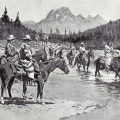
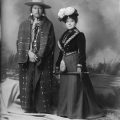
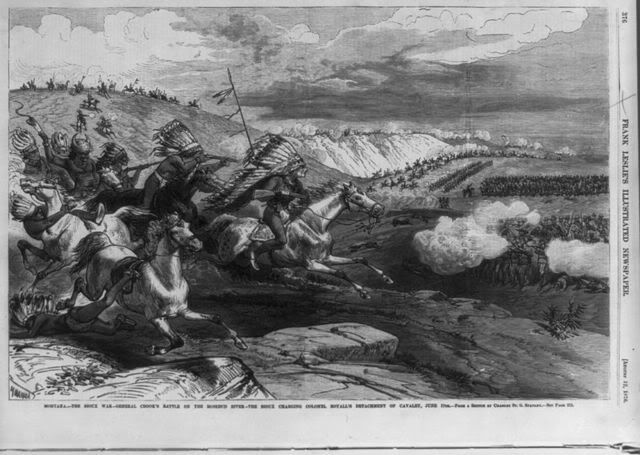
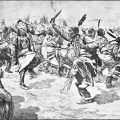
Leave a Reply